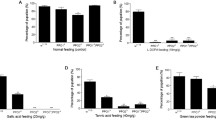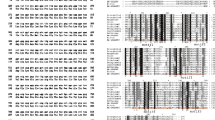Summary
WhenManduca sexta larvae are allatectomized 5 h before head capsule slippage (HCS) in the final larval molt, the new larval cuticle contains granules that melanize 3 h before ecdysis when the ecdysteroid titer falls (Curtis et al. 1984). In both the epidermis and hemolymph of these allatectomized larvae dopamine was higher than dopa prior to and at the time of melanization. Dopamine also increased in the new cuticle as melanization began. Dopa decarboxylase (DDC) activity increased in the epidermis, cuticle, and fat body beginning 16 h after HCS, with a two-fold greater increase in the epidermis of allatectomized larvae. Both α-MDH and α-fluoromethyl-dopa inhibited epidermal DDC activity and inhibited melanization in vitro when dopa was used as a precursor. Addition of dopamine to the medium allowed melanization in the presence of the inhibitors. All these results indicate that dopamine is likely the primary precursor of cuticular melanin. The diphenoloxidase in the premelanin granules was activated in vivo between 19 and 21 h after HCS and was found to prefer dopamine to dopa and not to convert tyrosine to melanin. The activation of the prophenoloxidase was inhibited by 20-hydroxyecdysone (20-HE), both in vivo and in vitro, if hormone was given by 16 h after HCS. Infusion of 1.2 μg/ml 20-HE into allatectomized larvae for 24 h from HCS prevented both the increase in DDC activity and the activation of the premelanin granules. Although the larvae ecdysed after a 15 h delay, melanization never occurred.
Similar content being viewed by others
Abbreviations
- α-MDH :
-
L-3-(3,4 dihydroxyphenyl)-2-hydrazine-methylpropionic acid
- α-FM-dopa :
-
R-S-α-fluoromethyl-dopa
- DCC :
-
dopa decarboxylase
- 20-HE :
-
20-hydroxyecdysone
- JH :
-
juvenile hormone
- HCS :
-
head capsule slippage
References
Ashida M, Dohke K (1980) Activaton of pro-phenoloxidase by the activating enzyme of the silkworm,Bombyx mori. Insect Biochem 10:37–47
Bearden JC Jr (1978) Quantitation of submicrogram quantities of protein by an improved protein-dye binding assay. Biochim Biophys Acta 533:525–529
Bell RA, Joachim FG (1976) Techniques for rearing laboratory colonies of tobacco hornworms and pink bollworms. Ann Ent Soc Am 69:365–373
Blois MS (1978) The melanins: Their synthesis and structure. Photochem Photobiol Rev 3:115–134
Curtis AT, Hori M, Green JM, Wolfgang WJ, Hiruma K, Riddiford LM (1984) Ecdysteroid regulation of the onset of cuticular melanization in allatectomized andblack mutantManduca sexta larvae. J Insect Physiol 30:597–606
Dohke K (1973) Studies on prophenoloxidase-activitating enzyme from cuticle of the silkwormBombyx mori. II. Purification and characterization of the enzyme. Arch Biochem Biophys 157:210–221
Hackman RH (1974) Chemistry of insect cuticle. In: Rockstein M (ed) The physiology of insecta, vol 6. Academic Press, New York London, pp 216–270
Hackman RH, Goldberg M (1971) Studies on the hardening and darkening of insect cuticles. J Insect Physiol 17:335–347
Hiruma K (1980) Possible roles of juvenile hormone in the prepupal stage ofMamestra brassicae. Gen Comp Endocrinol 41:392–399
Hiruma K, Riddiford LM (1984) Regulation of melanization of tobacco hornworm larval cuticle in vitro. J Exp Zool 230:393–403
Hiruma K, Riddiford LM (1985) Hormonal regulation of dopa decarboxylase during a larval molt. Dev Biol (in press)
Hopkins TL, Morgan TD, Aso Y, Kramer KJ (1982) N-β-Alanyldopamine: major role in insect cuticle tanning. Science 217:364–366
Hopkins TL, Morgan TD, Kramer KJ (1984) Catecholamines in haemolymph and cuticle during larval, pupal and adult development ofManduca sexta (L.). Insect Biochem 14:533–540
Hori M, Hiruma K, Riddiford LM (1984) Cuticular melanization in the tobacco hornworm larva. Insect Biochem 14:267–274
Kramer KJ, Morgan TD, Hopkins TL, Roseland CR, Aso Y, Beeman RW, Lockhart GL (1984) Catecholamines and β-alanine in the red flour beetle,Tribolium castaneum: roles in cuticle sclerotization and melanization. Insect Biochem 14:293–298
Locke M, Huie P (1980) Ultrastructure methods in cuticle research. In: Miller TA (ed) Cuticle techniques in Arthropods. Springer, New York, pp 91–144
Lunan KD, Mitchell HK (1969) The metabolism of tyrosine-O-phosphate inDrosophila Arch Biochem Biophys 132:450–456
Marsh JL, Wright TRF (1980) Developmental relationship between dopa decarboxylase, dopamine acetyltransferase, and ecdysone inDrosophila. Dev Biol 80:379–387
Maycock AL, Aster SD, Patchett AA (1980) Inactivation of 3-(3,4-dihydroxyphenyl) alanine decarboxylase by 2-(fluoromethyl)-3-(3,4-dihydrophenyl) alanine. Biochemistry 19:709–718
McCaman MW, McCaman RE, Lees GJ (1972) Liquid cation exchange — a basis for sensitive radiometric assays for aromatic amino acid decarboxylases. Anal Biochem 45:242–252
Meltzer YL (1971) Hormonal and attractant pesticide technology. Noyes Data Corp., Park Ridge, New Jersey
Needham AE (1978) Insect biochromes. In: Rockstein M (ed) Biochemistry of insects. Academic Press, New York, pp 233–305
Nicolaus RA (1968) Melanins. Hermann, Paris, pp 310
Pittendrigh CS (1965) On the mechanism of entrainment of a circadian rhythm by light cycles. In: Aschoff J (ed) Circadian clocks. North Holland, Amsterdam, pp 276–291
Porter CC, Watson LS, Titus DC, Totaro JA, Byer SS (1962) Inhibition of dopa decarboxylase by the hydrazine analog of α-methyldopa. Biochem Pharmacol 11:1067–1077
Raghavan KG, Nadkarni GB (1976) The tanning enzymes ofCorcyra cephalonica. Insect Biochem 6:201–205
Raghavan KG, Nadkarni GB (1978) Tyrosine metabolism in carbidopa and phenylthiourea administeredCorcyra cephalonica. Insect Biochem 8:53–57
Riddiford LM, Curtis AT, Kiguchi K (1979) Culture of the epidermis of the tobacco hornwormManduca sexta. Tissue Culture Assoc Manual 5:975–985
Roberts B, Baker M, Kotzman M, Wentworth SL (1982) A possible role of ecdysteroids in pre-ecdysial tanning in larvae ofSarcophaga bullata (Diptera: Sarcophagidae). J Insect Physiol 28:123–128
Swan GM (1974) Structure, chemistry, and biosynthesis of the melanins. Fortschr Chem Org Naturst 31:521–582
Tojo S (1980) Analysis of nucleic acid, protein, and uric acid. In: Ichinose T, Ishihara R, Matsumoto Y, Ohba S, Okada M, Saito T, Yoshitake N (eds) Methods in entomology. University of Tokyo Press, Tokyo, pp 13–28
Truman JW (1972) Physiology of insect rhythms. I. Circadian organization of the endocrine events underlying the moulting cycle of larval tobacco hornworms. J Exp Biol 57:805–820
Truman JW, Riddiford LM, Safranek L (1973) Hormonal control of cuticle coloration in the tobacco hornworm: Basis of an ultrasensitive assay for juvenile hormone. J Insect Physiol 19:195–204
Whitehead DL (1970) L-dopa decarboxylase in the haemocytes of diptera. FEBS Lett 7:263–266
Wirtz RA, Hopkins TL (1977) Dopa and tyrosine decarboxylation in the cockroachLeucophaea maderae in relation to cuticle formation and ecdysis. Insect Biochem 7:45–49
Author information
Authors and Affiliations
Rights and permissions
About this article
Cite this article
Hiruma, K., Riddiford, L.M., Hopkins, T.L. et al. Roles of dopa decarboxylase and phenoloxidase in the melanization of the tobacco hornworm and their control by 20-hydroxyecdysone. J Comp Physiol B 155, 659–669 (1985). https://doi.org/10.1007/BF00694579
Accepted:
Issue Date:
DOI: https://doi.org/10.1007/BF00694579




